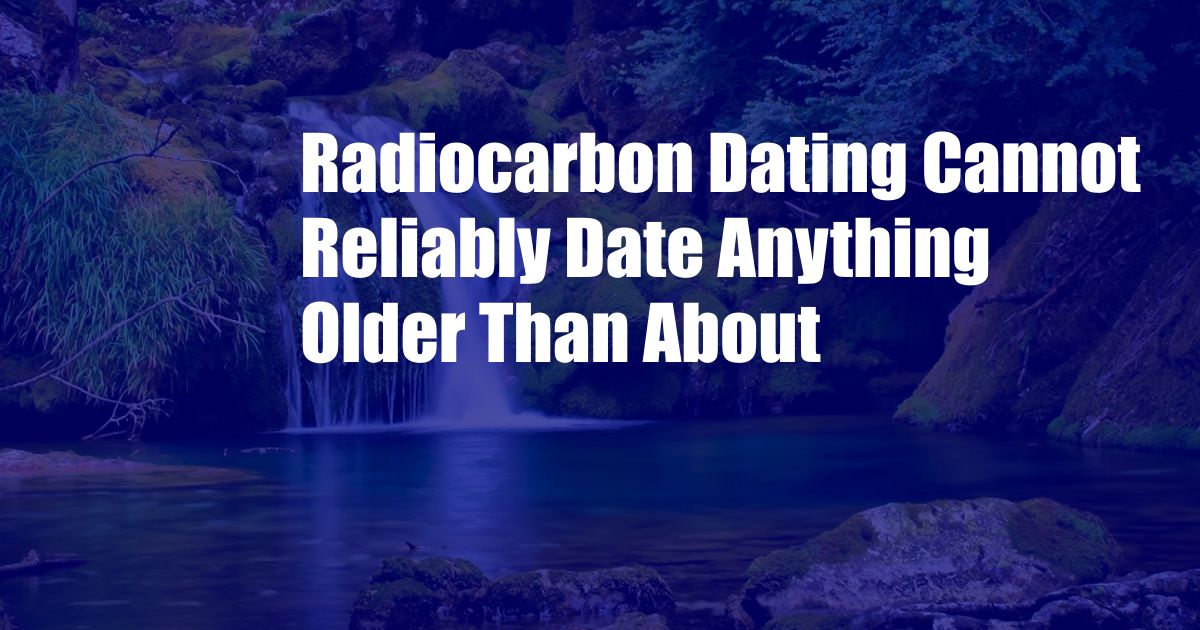
Radiocarbon Dating: Unreliable for Antiquities Beyond 50,000 Years
In the annals of archaeology and history, radiocarbon dating has been an indispensable tool for unraveling the chronology of human existence. It has allowed us to glimpse the past and understand the timeline of our species’ fascinating journey. However, despite its remarkable contributions, radiocarbon dating has limitations that prevent it from accurately dating materials older than approximately 50,000 years.
This limitation stems from the decay process that forms the foundation of radiocarbon dating. Organic materials contain a small portion of radioactive carbon-14, which gradually decays into nitrogen-14 at a known rate. By measuring the ratio of carbon-14 to carbon-12 in a sample, scientists can determine its age.
Delving into the Limitations: Beyond the 50,000-Year Threshold
Beyond 50,000 years, the amount of carbon-14 left in a sample becomes increasingly minute, making it challenging to obtain reliable measurements. This is because the half-life of carbon-14 is approximately 5,730 years, meaning that only half of the carbon-14 present in a sample remains after that period. After several half-lives, the remaining carbon-14 becomes so negligible that it falls below the detectable limit of radiocarbon dating techniques.
Moreover, other factors can further complicate radiocarbon dating for ancient materials. For instance, contamination from younger carbon sources or fluctuations in atmospheric carbon-14 levels over time can introduce errors into the dating process. As a result, radiocarbon dating is most accurate for dating materials within the past 50,000 years. For older artifacts, alternative dating methods must be employed.
Alternative Dating Techniques for Ancient Artifacts
Archaeologists and scientists have developed a range of alternative dating techniques to determine the age of ancient artifacts beyond the limitations of radiocarbon dating. These include:
- Potassium-Argon Dating: Measures the decay of radioactive potassium-40 into argon-40, with a half-life of 1.25 billion years, making it suitable for dating materials up to several million years old.
- Uranium-Lead Dating: Utilizes the decay of uranium-238 and uranium-235 into lead isotopes, with half-lives ranging from 4.5 to 13.4 billion years, enabling the dating of materials billions of years old.
- Dendrochronology: Analyzes tree ring patterns to determine the age of wooden artifacts, with a potential age range of several thousand years.
- Thermoluminescence Dating: Measures the accumulated energy released from certain minerals when heated, providing a dating range of thousands to hundreds of thousands of years.
Tips and Expert Advice on Radiocarbon Dating
To ensure reliable and accurate radiocarbon dating results, follow these expert tips:
- Minimize Contamination: Avoid handling samples with bare hands or exposing them to modern carbon sources, as these can lead to contamination and inaccurate dating.
- Use Calibrated Dates: Calibrate radiocarbon dates using regional databases to account for variations in atmospheric carbon-14 levels over time.
- Consider Multiple Samples: Obtain multiple samples from the same context to reduce the likelihood of error due to contamination or sample variability.
- Interpret Results Cautiously: Remember that radiocarbon dating has limitations, and interpret results with caution, especially for materials approaching the 50,000-year threshold.
Frequently Asked Questions
Why can’t radiocarbon dating be used to date materials older than 50,000 years?
Radiocarbon dating relies on the decay of carbon-14, which has a half-life of 5,730 years. After several half-lives, the remaining carbon-14 in a sample becomes too small to measure reliably.
Are there any alternative dating methods for ancient artifacts?
Yes, alternative dating methods include potassium-argon dating, uranium-lead dating, dendrochronology, and thermoluminescence dating.
How can I ensure reliable radiocarbon dating results?
Minimize contamination, use calibrated dates, consider multiple samples, and interpret results cautiously, especially for older materials.
Conclusion
Radiocarbon dating has revolutionized our understanding of the past, but its limitations must be recognized when dating materials older than approximately 50,000 years. By employing alternative dating techniques and following best practices, scientists can continue to push the boundaries of chronological research and uncover the secrets of our ancient world. Are you interested in learning more about the fascinating world of radiocarbon dating?